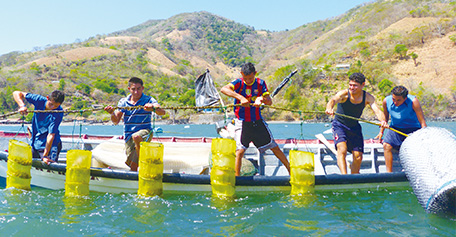Japan's Official Development Assistance White Paper 2013
Stories from the field 17
Ensuring Stable Incomes through Shellfish Aquaculture
– Technical Support for Shellfish Aquaculture in Eastern El Salvador –

Mr. Kani with shellfish farmers Ms. Aviles (right) and project counterpart Cornejo. (Photo: Syogo Ito)
The domestic economy in the Central American country of El Salvador was ravaged by the 13 years of civil war that started in 1979 and the large earthquake of 2001. The size of the country’s territory is small, and it has few natural resources, meaning that fishing and aquaculture industries are a major pillar of its economy. In other words, shellfish are an important source of income for fishers. However, the country’s civil war caused many people to flee to the coastline of the eastern region, and these people are now engaged in fishery, leading to a rapid decline in shellfish stocks. There are smaller and smaller shellfish available to small-scale fishers, and far less than they were once able to catch. Now they have to go much further to gather shellfish.
In addition, the work to catch the shellfish is very hard. Curil, a kind of shellfish related to the ark clam, like to live at the base of mangrove trees. People wade through the muddy tidal flats, gathering the curils gathered at the bases of these trees with their bare hands. That heavy labor is often carried out by women and children.
In an effort to establish a stable source of shellfish, JICA worked from 2005 to 2010 to produce the “seeds” (the young shells) of oysters and curils, implementing technical cooperation for aquaculture. From 2012, JICA carried out the “Production Improvement and Extension of Shellfish Aquaculture Project” in the Departments of Usulután and La Union in order to spread proven techniques to a fishers over a wider region.
Mr. Kiyotaka Kani served as Chief Advisor on this project. He is an expert at shellfish and fish aquaculture. He has worked as an expert supporting aquaculture in Chile, Morocco, and El Salvador since 1983. He explained the project’s significance, “Small-scale fishers will have unstable incomes if they rely only on natural resources. They need to not only catch shellfish, but also realize diversified sources of income that includes coast fishing and chicken farming. Shellfish aquaculture has the great potential to stabilize and grow the fisher incomes.”
Getting fishers over a wide area to start shellfish aquaculture required that the project aim for the mass-production of young shells. The aim was to produce five million curils and young oyster shells per year. The project teamed up with other assistance agencies to spread the aquaculture project across the region. The project first examined the issues that would need to be resolved towards the mass-production of young shells.
For oysters, the team revised the water tank design in which parent oysters had been raised to introduce an improved water tank that made management simple. The project succeeded in producing one million young shells over the course of one spawning, raising expectations for mass-production. Curil can spawn five times in one year. Although the local staff was able to sufficiently learn the techniques used, the project realized that many of the shellfish were dying as they grew, and so consideration is now underway on how to stabilize the growing period moving forward. Work to expand the young shell production facilities completed in July 2013, and it will soon be time for a trial of all out mass production to begin.
In addition to the trial production of oysters, the project also laid plans for the pioneering of shellfish markets. Currently, those involved with production have been divided into four groups, and they are implementing aquaculture project and started undergoing training towards the commercialization of their products. Mr. Kani is working to transfer techniques to the local fishers, including marketing and market development methods as well as sales devices. “If the small-scale fishers can get involved in the sale of their own shellfish and acquire management knowledge through their involvement in not only production but shipping, they will be able to raise their own incomes on their own.”
Mr. Kani has recently been receiving excited requests from neighboring groups and from other districts for help with producing young shells after seeing the effect of these practical aquaculture trials. He realizes the local people have high expectations. Furthermore, he is aiming to use the techniques devised thus far to develop new cultivars and to make this Center of Fisheries and Aquaculture Development into the core of shellfish aquaculture research in Central America.

Oyster aquaculture at the island of Conchaguita in the Gulf of Fonseca in the Department of La Unión. (Photo: Christopher Escobar)
